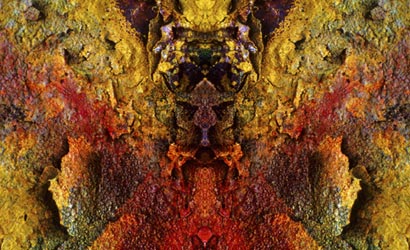You Can Do It: Make Photo Abstractions
Hungry for gorgeous, detailed abstractions? Make an image sandwich.

Photo abstractions have been enjoyably and creatively energizing for me for 10 years. My favorite way to make them is through montage. Sandwiching identical slides is an alternative way to interpret landscapes, natural subjects, or manmade patterns, such as the close-up of graffiti used for the montage on the previous pages. (While I prefer using slides, you can get the same results digitally with image-editing software such as Adobe Photoshop.)
Ironically, Pop Photo got me started with an article back in September 1994 about making soft-focus images by sandwiching two slides of the same scene: one in focus, the other not. My montages on these pages derive directly from that technique.
Here’s how it works for film shooters: With your camera on a tripod, make two identical images on slide film, each overexposed by about 1 stop. After processing the film, sandwich the slides, emulsion-to-emulsion, to form a seamless, symmetrical image. Next, secure the slides in a glass mount (Gepe makes the best), taping them into position to maintain registration.
Natural landscape subjects (foliage, grass, sand patterns) offer a wide variety of patterns and colors. Get maximum detail by using small apertures that maximize depth of field, and by shooting on sunny days with a polarizer to increase contrast.
You can alter or enhance the symmetry by “flipping” a slide. I tend to start with a conventional emulsion-to-emulsion montage in which the slides share their original orientations. If the image doesn’t wow me, I rotate or flip one of the two identical slides so they’re still emulsion-to-emulsion, but north and south are juxtaposed. If it’s still lacking, I start all over by viewing the montage in the opposite orientation — portrait instead of landscape, for example.
Because there’s almost no way to predict whether a scene will produce a good sandwich, I don’t go out looking for them. Instead, I try to shoot the best landscapes and close-ups I can, and then overexpose a few frames to sandwich later. Wide-angle, telephoto, and macro images can all be made into montages. Not every composition will montage, but I hope for, and often get, more surprises than duds.
Bonus Tips
• Use a sturdy tripod and a cable release to minimize camera movement between images.
• Feel free to use any filter you need to make a good image.
• Using the aperture-priority AE mode on my Olympus OM-4, I bracket exposures from + 2/3 to + 1 1/3.
• In general, the sharper and more contrasty the image, the more its patterns will pop.